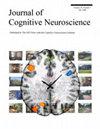个人空间客体所有权加工的脑电图研究。
IF 3
3区 医学
Q2 NEUROSCIENCES
引用次数: 0
摘要
与环境中物体互动的一个基本方面是能够区分在周围空间(PPS)中可以直接作用的物体和在超个人空间(EPS)中无法直接接触的物体。执行适当的行动还需要整合与谁拥有特定对象相关的社会概念信息。虽然先前的研究表明空间和社会因素会影响物体处理,但这些因素是如何整合的还没有完全理解。为了解决这一问题,本研究探讨了当物体位于PPS或EPS时,物体所有权加工的神经生理学相关性。面对一个虚拟人物,28名参与者估计了放置在不同距离上的自己拥有或他人拥有的物体的可及性。分析证实,自拥有对象在PPS中处理速度更快,他人拥有对象在EPS中处理速度更快。脑电图信号分析表明,早期ERP成分,如N1和前N2,仅受物体空间位置的调节。相比之下,后来的组成部分,包括P3和前N400,受到物体所有权的影响,尽管这取决于物体在空间中的位置。这些结果表明,在PPS中物体的早期感知优先级和在后感知阶段参与自我的物体优先级。总的来说,这些发现为研究物体如何根据其空间和社会属性被处理提供了新的见解,并证实了虚拟现实是一种有前途的工具,可以探索支持社会背景下感知和行动的神经机制。本文章由计算机程序翻译,如有差异,请以英文原文为准。
Object Ownership Processing in Peripersonal Space: An Electroencephalographic Study
A fundamental aspect of interacting with objects in the environment is the ability to distinguish between objects that can be directly acted upon in the peripersonal space (PPS) and those out of immediate reach in the extrapersonal space (EPS). Performing appropriate actions also requires integrating social conceptual information related to who owns a particular object. While prior research has demonstrated that spatial and social factors influence object processing, how these factors are integrated is not yet fully understood. To address this issue, the present study explored the neurophysiological correlates of object ownership processing when objects were located in either the PPS or EPS. Facing a virtual character, 28 participants estimated the reachability of self-owned or other-owned objects, placed at different distances. The analysis confirmed that self-owned objects are processed faster when located in PPS, and other-owned objects are processed faster when located in EPS. EEG signals analysis revealed that early ERP components, such as the N1 and anterior N2, were modulated solely by objects' spatial location. In contrast, later components, including the P3 and anterior N400, were influenced by object ownership, although depending on object's location in space. These results suggest an early perceptual prioritization of objects in the PPS and a prioritization of objects that engages the self at a postperceptual stage. Overall, the findings provide new insights into how objects are processed depending on their spatial and social properties, and confirm that virtual reality represents a promising tool to probe neural mechanisms supporting perception and action in social contexts.
求助全文
通过发布文献求助,成功后即可免费获取论文全文。
去求助
来源期刊
CiteScore
5.30
自引率
3.10%
发文量
151
审稿时长
3-8 weeks
期刊介绍:
Journal of Cognitive Neuroscience investigates brain–behavior interaction and promotes lively interchange among the mind sciences.

 求助内容:
求助内容: 应助结果提醒方式:
应助结果提醒方式:


